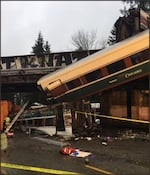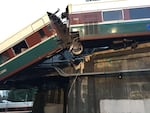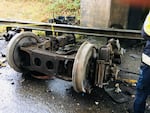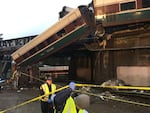UPDATE (Tuesday, 7:34 a.m. PST) – The Amtrak Cascades train that derailed in DuPont, Washington, during Monday's morning commute was meant to be the celebration of a new, faster route between Seattle and Portland.
“After years of work planning and constructing almost $800 million in passenger train improvements, we're excited to be just days away from saying ‘All Aboard!’ to our new, expanded Amtrak Cascades service,” the Washington State Department of Transportation wrote on its website last week.
Instead, at least three people died, the Washington State Patrol confirmed late Monday. Many others were injured as 13 of the 14 Amtrak passenger cars leaped from the tracks. One car and a locomotive fell onto the southbound lanes of Interstate 5, closing the highway for the foreseeable future.
The National Transportation Safety Board said late Monday the train was traveling 80 miles an hour — 50 miles an hour over the posted speed limit for trains in that stretch of track.
What is Amtrak Cascades?
The rail service, as well as its trains and engines, are owned and managed by Oregon and Washington state and operated by Amtrak. The line runs from Eugene to Vancouver, British Columbia. It is primarily funded by ticket revenues and the two states.
Monday was supposed to mark the beginning of expanded service between Portland and Seattle with six round-trip trips per day. A separate passenger line, Amtrak Coast Starlight, would also travel the new route once per day.
In 2016, about 867,000 people rode Amtrak Cascades, according to Janet Matkin, communications director for WSDOT.
“Seattle to Portland is the most used route,” she said at a Dec. 4 meeting. “That’s why we’re adding additional trips between Seattle and Portland to ensure that we meet that demand.”
The average train carried about 250 people, Matkin said. Monday's train carried around 80 people when it came off the tracks.
How does the derailment get investigated?
A “go team” from the National Transportation Safety Bureau is on the scene. They’ll lead the investigation. They’ll likely issue a final report in the coming weeks.
WSDOT traffic cameras that may have captured the derailment were not recording at the time, agency officials told OPB.
The maximum speed around the curve where the train derailed is 30 miles per hour, according to Kimberly Reason, a spokesman for Sound Transit, which owns the section of track.
Related: NTSB: Amtrak Train Going 80 MPH In 30 MPH Zone When It Derailed
The maximum speed the Amtrak Cascades trains can travel is 79 miles per hour, she said. Speed signs are posted just before an approaching curve and two miles before a speed zone change, her email stated.
However, the train did have positive train control, which is a device that automatically slows trains down for safety if needed. That device was not engaged before the crash, according to Amtrak officials.
The derailed train was, according to a preliminary investigation, going 80 mph before it came off the tracks, the NTSB said.
Oregon Congressman Peter DeFazio, the ranking Democrat on the House Transportation and Infrastructure Committee, said the crash may lead Congress to demand additional safety provisions.
“When we get to the bottom of this, we’ll see what needs to be rectified,” said DeFazio, adding that Amtrak is “still one of the safest modes of travel considering the number of people we move.”
Why was the train traveling on new tracks?
The upgrades were part of $800 million in capital improvements meant to reduce delays south of Tacoma. Amtrak Cascade shared the tracks with oil and other freight trains.
Former WSDOT Director Lynn Peterson, who headed the agency as it worked on the upgrades, said the goal was to improve the reliability of passenger trains.
Related: Amtrak Train Hurtles Off Overpass; At Least 3 People Killed
“It was less about getting higher speed and more about less getting pushed onto a side track and waiting for coal and oil trains to pass by,” Peterson told OPB.
The new section of track is called the Point Defiance Bypass. It moved the trains inland from Puget Sound onto a new section of track that run through DuPont and Lakewood.
Typically, it takes between three and four hours to make the trip between Seattle and Portland. The new route would reduce travel time by about 10 minutes, according to transportation officials.
The bypass’ budget is $180.7 million, according to the WSDOT.
New route controversy
Even before Monday’s fatal derailment, cities along the new Amtrak route had been been voicing safety concerns for more than a decade. One of them is Lakewood, Washington.
In 2013, the city filed a lawsuit with the Pierce County Superior Court, suing WSDOT in an attempt to stop the project. The city argued the rail project had not undergone a full environmental review. In 2014, a judge dismissed the city’s case.
For Lakewood city officials, the biggest concern was public safety and the number of railroad crossings through town. According to legal documents filed by the city, access to the Lakewood's Tillicum neighborhood is limited and requires all vehicles to cross the railroad tracks.
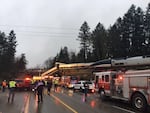
A Portland-bound Amtrak train derailed near Tacoma, Wash., Monday, Dec. 18, 2017.
Pierce County Sheriff's Department
State transportation officials countered that crossings would be brief, on average lasting 45 seconds. WSDOT also rolled out a public awareness campaign alerting residents along the route about the faster trains, even enlisting the help of Seattle Seahawks receiver Doug Baldwin.
“This is not popular with the city at all,” said Lakewood City Councilman John Simpson by phone Monday morning. “It is an issue that the city of Lakewood was adamantly opposed to in order for the train to save six minutes of travel time.”
Before the new Amtrak rail realignment, less frequent trains through Lakewood traveled at slower speeds and typically were used for freight traffic. The Amtrak passenger trains can travel at speeds as high as 79 miles per hour.
Just two weeks ago, Lakewood Mayor Don Anderson cautioned WSDOT officials about the potential for a deadly crash, referring to possible accidents at on-grade crossings.
“This project was never needed and endangers our citizens for very little, highly-subsidized transportation enhancements,” Anderson said at the meeting. “While it’s a great project for bureaucrats, it’s a terrible one for the community.”
And while it's not clear what led to the train derailment Monday, Lakewood city officials were quick to point out a long history of opposition toward the project.
When will Interstate 5 reopen?
It's not clear when travel will return to normal in the area of the crash.
I-5 is the major north-south corridor for the entire West Coast. With holiday travel already underway, there’s added pressure to get the highway reopened.
The Washington State Patrol said late Monday that Tuesday morning’s commute would likely be affected, but it wouldn’t give a specific estimate of when the road would reopen.
Police and other officials have asked those who don’t need to travel to stay off the roads and telecommute if possible.
OPB’s Jeff Mapes and Lauren Dake contributed to this report.
Editor’s Note: This article has been updated to reflect that the derailment impacted the southbound lanes of Interstate 5.
